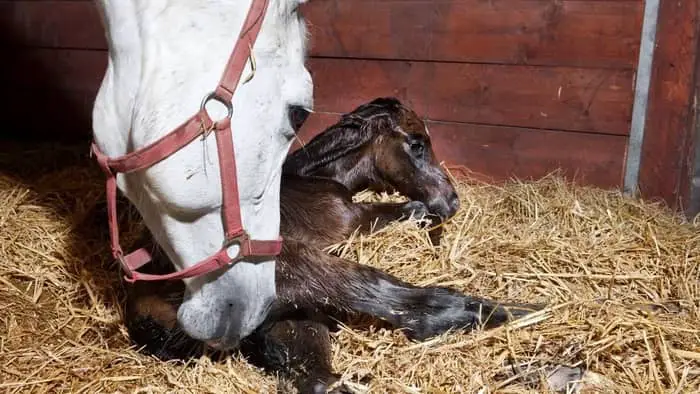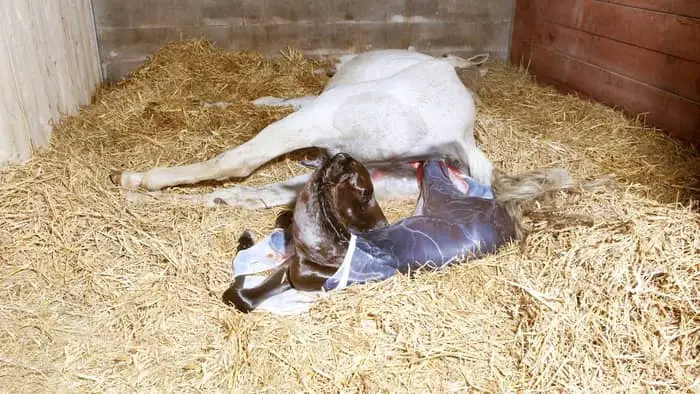Last Updated on February 20, 2022 by Griselda M.
When a horse has a foal for the first time, it can be difficult to predict when she is going to give birth. Understanding how to recognize foaling signs in maiden mares can help us to know when the foal is likely to be born.
The birth of a new foal is an exciting time for any horse owner, but this also comes with a lot of worries! Understanding how to spot when a maiden mare is foaling can help to take the concern out of this tricky time. Let’s find out how to identify foaling signs in maiden mares!
How To Spot Foaling Signs In Maiden Mares
A horse pregnancy can last from 320 to 390 days, which gives a huge time frame in which the mare might give birth. Predicting the foaling date becomes even trickier with a maiden mare, as we have no past history to go on.
But why is it so important to know when a mare is going to foal? Giving birth is a difficult and tricky process for a horse, and many things can go wrong. And while it is best to leave the mare undisturbed when she is giving birth, we need to know when it is happening so we can help if necessary.
If a mare has problems giving birth, a swift veterinary intervention will give the best possible chance of survival of both the mare and foal. When we think a mare is imminently going to go into labor, we can watch her discreetly using either a small window or CCTV camera. This allows us to give her the peace and privacy she needs, whilst monitoring in case anything goes wrong.
The most likely time that a mare will give birth is during the night, and if we don’t know when she is going to foal this can lead to a lot of sleepless nights! So if we can spot the signs that she is going to give birth, we can ensure that we don’t miss the big event.
Here are the most common signs that a maiden mare is going to give birth:
Pregnant mare belly shape
One of the key signs that a maiden mare is going to foal is that her belly shape starts to change. During the last trimester of her pregnancy, her abdomen will become increasingly large, particularly widthways. This is because the foal does most of its growth during the final months of pregnancy.
At the end of a mare’s pregnancy, the abdomen will be round and distended – if you stand behind her, you will see her belly protruding from either side of her flanks. During the last week of pregnancy this shape changes, as the belly drops downwards. The weight of the foal will be carried under the abdomen, rather than bulging out to the sides.
Foal movement before birth
As the foaling date approaches, you may start to spot movement of the foal. Watch the flanks of the mare closely, and as the foal moves you will see the skin of the mare pushed outwards. This can happen for several weeks before the mare gives birth, so it is not a reliable indicator that a maiden mare is about to foal.
However, during the first stage of foaling, the amount of movement will increase considerably. This is because the foal is turning around to achieve the optimum position for the birth. During this time the mare will appear uncomfortable, swishing her tail and kicking at her abdomen.
Mare waxing up
Waxing up is one of the most reliable foaling signs in maiden mares. As the foaling date draws closer, you will see that the mares’ udders have started to swell in preparation for feeding the foal. This can happen several weeks before foaling, but 2 to 4 days before birth the teats will start to develop a waxy secretion.
This wax is actually a substance called colostrum, which is the first milk the foal will drink. It contains essential antibodies and nutrients and is vital for the health and well-being of the newborn foal. When you see these waxy secretions on the mare’s teats, it is likely that she is going to foal in the next few days.
At this stage, it is important to check the teats regularly. Some mares will start to drip colostrum, particularly in the final 24 hours before foaling. This can lead to a reduced amount of colostrum available to the newborn foal.
Summary
So, as we have learned, the foaling signs in maiden mares include a change in the shape of the abdomen and the formation of waxy secretions on the teats. It can be difficult to accurately predict when a maiden mare is going to foal, so it is helpful to be able to monitor her using a CCTV camera. If the mare has difficulties foaling then it is essential that veterinary help is sought immediately.
We’d love to hear your thoughts on foaling signs in maiden mares! Have you ever been lucky enough to see a foal being born? Or maybe you’ve got some questions about how to know when a mare is foaling? Leave a comment below and we’ll get back to you!
Read more about How To Tell If Your Mare Is Pregnant?
FAQs
Do Maiden Mares Usually Foal Early Or Late?
When a mare has her first foal, it can be difficult to predict her foaling date. It is not uncommon for an inexperienced mare to foal later than expected. She may also give misleading signals, such as premature udder development.
Luckily, if the mare is pregnant again, it will be much easier to figure out when she is due to foal! This is because each mare will follow the same pattern of behaviour every time she foals. The gestation length tends to be the same for every foal apart from the first one.
How Soon Before Foaling Does A Mare Bag Up?
Bagging up is the name used for when a mare's udders start to swell in preparation for feeding her foal. Udder development can begin to occur from 3 to 6 weeks before foaling, or even sooner in maiden mares.
As the due date comes closer, you will see a waxy substance on the teats caused by the formation of colostrum. If milk starts to leak from the teats, the mare is most likely going into the early stages of foaling.

